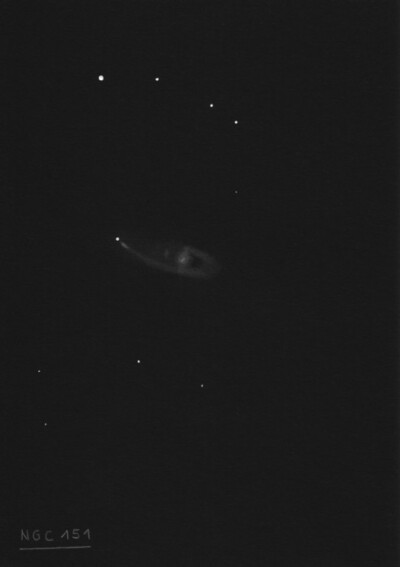
NGC 151 is a mid-sized barred spiral galaxy located in the constellation Cetus. The galaxy was discovered by English astronomer William Herschel on November 28, 1785. In 1886, Lewis Swift observed the same galaxy and catalogued it as NGC 153, only for it later to be identified as NGC 151.The galaxy, viewed from almost face on, has several bright, blue, dusty spiral arms filled with active star formation. One noticeable feature of the galaxy is a large gap between the spiral arms. Two supernovae have been observed in NGC 151. On 22 July 2011, PTF11iqb (type IIn, mag. 17.1) was discovered, and on 24 June 2023, SN 2023lnh (type Ia, mag. 18) was discovered.
300/350mm - 13.1" (8/24/84): fairly bright, bright core, very bright nucleus, very faint halo elongated ~E-W. A faint star is at the ENE edge.
400/500mm - 17.5" (9/17/88): moderately bright, moderately large, oval 5:3 WSW-ENE, 2.5'x1.5', bright nucleus. A mag 13 star is at the ENE edge, 1.7' from the center.
600/800mm - 24" (12/1/16): bright, fairly large, contains a very bright boxy rectangular central section that is slightly elongated NNW-SSE (this is the central bar and nucleus), encased by a fairly low surface brightness halo extended at least 2:1 E-W, ~2.7'x1.2'. A mag 12.5 star is at or just off the ENE edge (1.7' from center). A superimposed companion is at the tip of the eastern spiral arm of the galaxy, very close southwest of the mag 12.5 star. It was marginally glimpsed but only occasionally popped.
900/1200mm - 48" (10/29/19): very bright striking spiral with an inner ring and a long, drawn out spiral arm! Overall, at 610x the galaxy extended over 2:1 WSW-ESE, ~3.2' x 1.4'. Very strongly concentrated with a very bright core that gradually increased to the center. Immediately west of the core was a noticeably darker gap and a lower contrast gap was east of the core. These gaps were outlined by bright arcs, each about 90°, creating a partial oval ring surrounding the core.
The western half of the halo had a low surface brightness and extended at least 1.5' from the center. I noticed a brightening at the extreme west end of the halo. Checking the SDSS, this is a split spiral arm, separated beyond a darker dust lane. A thin, long spiral arm was attached at the south side of the core (along the inner ring) and was easily seen gently curving northeast, extending directly to a mag 12.6 star!
A small, faint knot, at most 10" diameter, was easily seen near the end of this arm, very close SSW [16"] of the mag 12.6 star. This "knot" is a companion galaxy (2MASX J00340814-0941481), though its redshift is 1/3 greater than NGC 151, so it may be in the background.